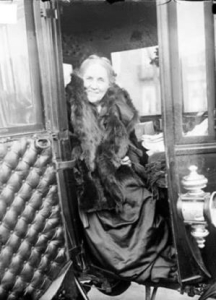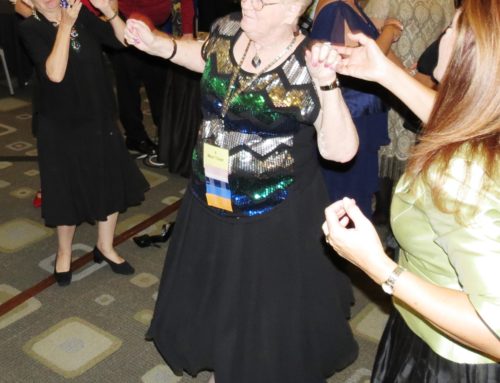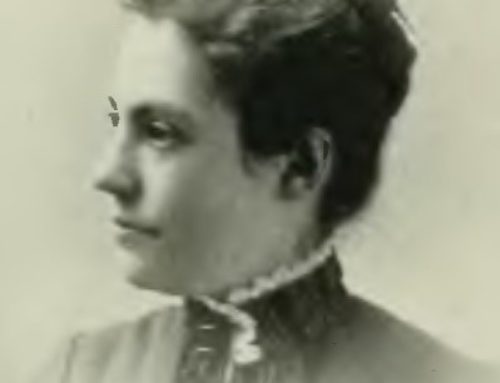Helen Ekin Starrett was exactly the type of woman who lived her life to the fullest. In constant motion as a wife and mother, she also took on the roles of author, editor, publisher, inventor, educator, reporter, respected business woman, Temperance member, volunteer and mentor.
A long-time suffragist, she was one of two delegates in the nation who attended both the first National Woman Suffrage Association convention in Washington D.C., in 1869 and the Victory Convention in Chicago, in 1920. It made Helen an irrepressible icon. The New York Sun reported attendees knew where Helen was at the Victory Convention “due to the constant mobs of women of all ages surrounding her.” They all wanted to meet her. She lived to see the 19thAmendment to the United States Constitution passed by Congress on June 4, 1919 and ratified on August 18, 1920, and was one of only six women electors to the Hall of Fame of New York University. She was a close friend to Susan B. Anthony.
Born Helen Martha Ekin on September 19, 1840, in Pittsburgh, Penn., to Rev. John Ekin DD and Esther Fell Lee, of Scotch-Irish Presbyterian descent and the Fells of Longlands, England, she was the oldest of six children. Of the five girls and one boy, not all survived to live such a long life as Helen did. At the age of 17, Helen graduated from the public high school in Pittsburgh, Pennsylvania, and immediately began teaching.
In February, 1864, at the age of 24, she married her childhood sweetheart Rev. William Starrett and moved to Lawrence, Kansas, taking on the role of pastor’s wife in the pioneer community. Not content in that role, Helen quickly returned to teaching music, served as a newspaper editor, assisted her husband in his school superintendent duties, and became one of the state’s leading speakers and lecturers on the Suffrage Movement. When her husband left the church to begin to study law, it was Helen who stepped in to support their growing family. According to Helen’s great-great granddaughter, Julie Phelps, Helen and William had two daughters and five sons. Helen supported her family by writing for various national publications and lecturing. She invented two devices for the improvement of ladies’ shoes and had her inventions parented with the National Patent Office. After William passed the bar, the family relocated to Chicago in 1880 where she founded Western Magazine. After three years, the magazine closed and Helen once again returned to teaching.
Helen was founder and principal for nine years of the Kenwood Institute, a classical school for girls and later founded and incorporated the Starrett School for Girls, both located in the Kenwood Community of Chicago. Founded in 1883, the Starrett School was one of the city’s oldest private schools, a large day school with accommodations for resident pupils providing classes from kindergarten to college preparation. At one time, its quarters were housed in a fine Gothic house, replica of a famous French chateau built in 1900 as a residence for John G. Shedd.
Helen became the second elected president of the Illinois Woman’s Press Association in 1893 and served the Association during the year of the World’s Columbian Exposition also known as Chicago’s World’s Fair. She was the toastmistress presiding over the earliest IWPA social gathering on record on January 26, 1893. Chicago newspapers reported the “meeting and family supper” held at the Palmer House Hotel in Chicago’s Loop with nearly “200 brilliant women” in attendance featured readings and speeches given by Caroline A. Huling, Ursula N. Gestefeld and Sallie M. Moses. Mrs. Isabel Laning Candee, an active member of the Illinois State Board of Lady Managers of the World’s Fair spoke to those assembled of the “New Discovery, a reference to women who fought and won in literary battle.”
At the age of 47, Helen was left a widow and single mother of their seven children, her youngest was only ten years old when his father died. The sons all became builders, and Helen’s daughters married builders.
An interesting note in her family’s rich history includes Helen’s son, Paul Starrett. In 1888, Paul entered the Daniel Burnham and John Roots architectural firm where he first worked as a tracer and stenographer, then as a draftsman. Burnham went on to make Starrett superintendent on two buildings for the World’s Columbian Exposition in 1893 – Machinery Hall and the Mines and Mining Building. In 1897, Starrett had made a move to the George A. Fuller Company of Chicago, by 1905, he was vice president of the Fuller Company, and then he became its president, a position he held for the next seventeen years (1905-1922) During Starrett’s tenure as president at Fuller, the firm built many of the biggest projects undertaken in the United States prior to the First World War including Pennsylvania Station, the Biltmore hotel and under his supervision the Bellevue Stratford Hotel, the Plaza and Flatiron buildings were erected.
All of Helen’s sons became well-known and respected builders with their own construction firms, Starrett Brothers and Ekin in New York City having built some of Americas most treasured skyscrapers and buildings. In 1930, the two firms became Starrett Brothers Corporation and were responsible for changing the landscape of New York with buildings that include the New York Life Insurance Building, the (former) McGraw Hill Building, the landmark Empire State Building. The Lincoln Memorial in Washington, D.C. was one of Starrett’s other many projects.
Much of Helen’s literary success included several books, poems, lyrics and national articles, many of which can still be found on the Internet today including: Letters to a Daughter (1882), The Future of Educated Women (1880), The Charm of Fine Manners (1885), The Future of Our Daughters, and After College; Now What? (1885). Along with her sister, Frances Ekin Allison, she authored a volume of poems, Crocus and Wintergreen (1907). For many years, Helen was also on the editorial staff of a variety of popular weekly magazines.
Newspaper publisher, the founder of the Chicago Daily News, and general manager of the reorganized Associated Press, Melville E. Stone wrote about Helen in his book, Fifty Years a Journalist. As a member of his staff, he stated, “Helen Ekin Starrett wrote with a masculine pen and dealt brilliantly with almost every conceivable topic.”
When Helen “retired” to Portland, Oregon in 1916, The Oregon Daily Journal printed a story about her role as the new president of the Ainsworth Parent-Teacher Association. She remained active in education and social matters, and attributed these things to be the secret to her youth. “Keeping up my interest in life, constant association with the young and simple habits of living,” she said, also factored in to her longevity. She passed away four years later at the age of 80.
Her message to women though remains startling relevant. For as far as women have advanced their choices and earning potential have not. History Professor, Roseland Rosenberg, speaker at the 2002 Barnard College Commencement Ceremonies titled her address, “After College What?” complimenting Starrett’s book of the same title. She said, “Starrett described what she called the ‘blank nothingness’ that a young woman confronted upon receiving her bachelor’s degree. What came after college, students wondered. They had no adequate answer, Starrett lamented. Brothers might go on to law or medical school; they might go into public service or business; they might enter the ministry or academe. A woman could pursue none of these paths. She could do only the things for which a college education was not necessary – return home, teach, or marry. But these choices no longer seemed enough.”
Through her life-long efforts, Helen filled not only her own life to the brim by educating, offering inspiration and mentoring young girls and women throughout our country. She was more than a woman of insight and integrity to many. Today, Helen’s trail-blazing spirit remains a treasure in the archives of IWPA.





Leave A Comment